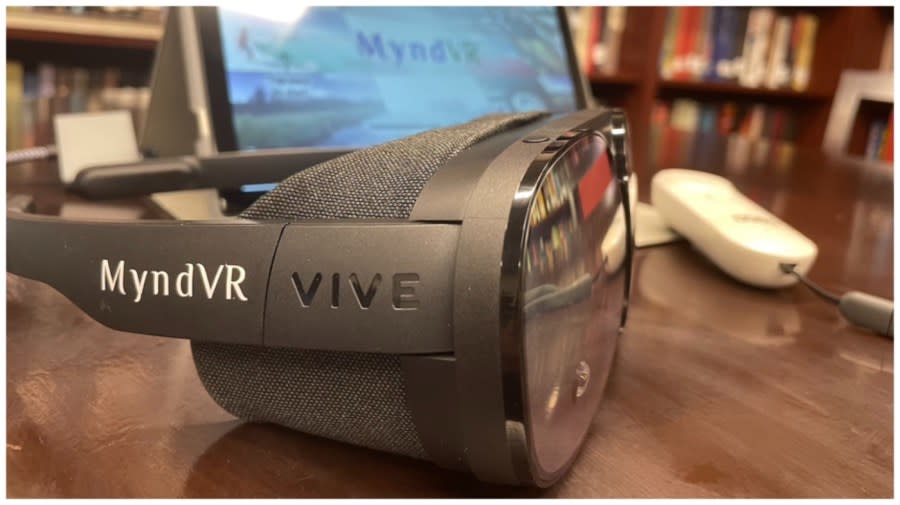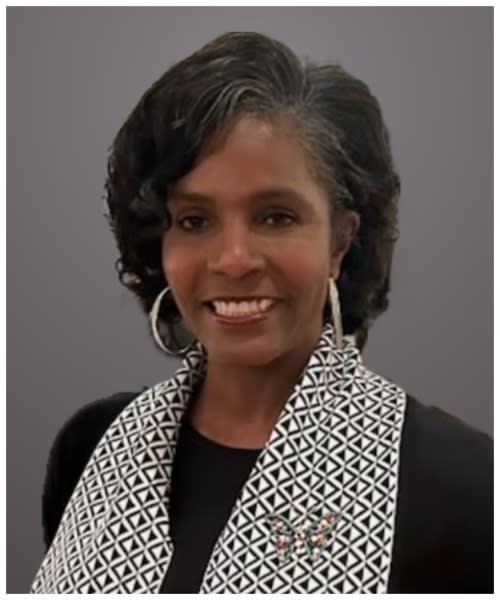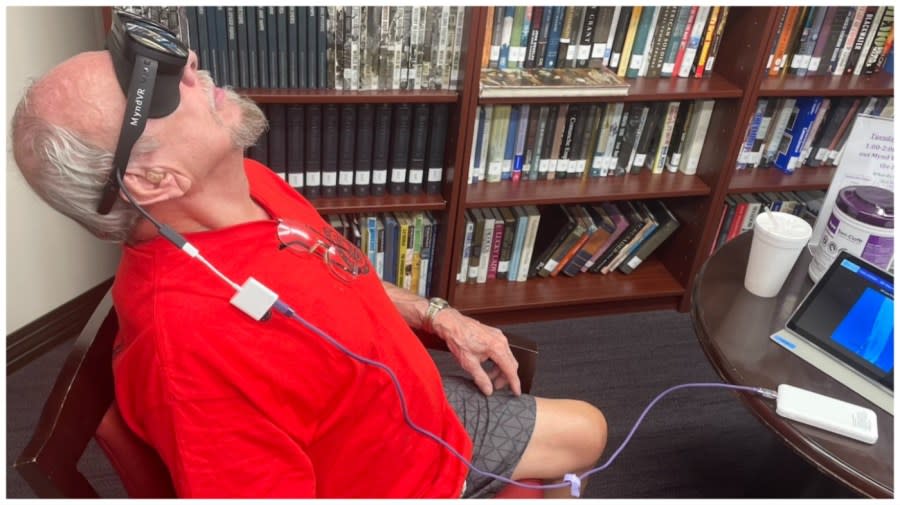How veterans are using virtual reality to cope with PTSD

Retired Command Sgt. Maj. Tonya Oxendine, who served in Iraq and Afghanistan, struggled with post-traumatic stress disorder (PTSD) for nine hard years before she began her path to recovery.
Her pain reached a point where, one day after leaving her desk at the Pentagon, she was considering driving off a bridge.
“I was at the brink to take my life,” she said, but then “all I could think about was my two sons and I kept thinking about them and thinking about them and I said I cannot leave a legacy of suicide.”
Oxendine turned her car around and sought help, enrolling in a treatment plan through the Wounded Warrior Project and was introduced to a virtual reality (VR) headset in 2017.

Today, the 58-year-old credits VR as a major part of her recovery, with the technology returning her to Afghanistan to deal with her memories in a new light through a treatment called prolonged exposure.
“I am winning at life right now,” she said.
The idea of prolonged exposure is to re-experience troubling memories, which VR can help unlock in ways not possible before, bringing veterans back to the inside of a Humvee along the dirt roads of Iraq or into the jungles of Vietnam.
Afterward, veterans can debrief and employ cognitive therapy, learning to process the memories in a new and hopefully better way, while in a safe and controlled environment. The goal is to change how they feel about the memory instead of avoiding it in constant fear.
Oxendine said she was terrified at first, comparing it to being experimented on like “Frankenstein,” but she gradually began to understand that she must confront her fears.
Once she put on the headset, Oxendine could see mountains and “narrow roads that we used to travel down” in Afghanistan.
“I could see burning and abandoned vehicles on the side of the road and bicycles,” she said, and she could see wounded soldiers. “I could still smell the blood, I can hear them whimpering in pain.”
“I was emotional. I was scared. I mean, just all just all kinds of emotions running through,” she added, but “it was a controlled environment. I was not alone. … I’m glad I did it because I feel better. Now, I’m able to handle my mental health in a healthy way.”
While Apple and Meta have made headlines for launching new mass-market VR headsets in recent months, the potential for the technology to address serious and persistent issues like PTSD in medical settings is often overlooked.
Oxendine is one of thousands of veterans who are already using VR to treat PTSD as the technology picks up attention across the nation.
Among the major companies working on this initiative is Dallas-based Mynd Immersive, which was founded in 2016. Mynd has 500 headsets in nearly 100 long-term veteran care facilities and says it has the largest private VR network for veterans in the country, if not the world.
The company works with both the federal Department of Veteran Affairs (VA) along with state agencies and groups that help veterans. One popular program at Mynd returns veterans to the USS Eisenhower aircraft carrier.

Mynd co-founder and CEO Chris Brickler said members of his family struggled with dementia and he was inspired to help by new technology, including Meta’s Oculus headsets.
“We are — after seven years now — very well poised to help with a lot of the aging issues with our seniors and veterans,” he said.
At the Davis and McDaniel Veterans Care Center, which is run by the state of Virginia in Roanoke, the Mynd VR headset is already a hit.
On one Tuesday afternoon, a group of veterans were gathered in a small library near the front of the center to wear the headsets. The small, black goggles fit neatly around one veteran, whose experience inside the immersive world of an aircraft high in the sky could be viewed from a tablet connected to the headset.
For retired Army Sgt. Melvin Huff, 73, VR is a way to take his mind off things.
“It’s a way of escaping,” he said, mentioning he likes the whitewater rafting VR experience. “If you’re having a bad day, you pick something that’s enjoyable to look at and you feel better.”
Retired Army Spec. Bob Rutherford, 72, who also served in Vietnam, sees it the same way.
“It will take your mind off things that you sit and think about,” he said.
Maeghan Hubbard, the activities director at the center, was trained by Mynd on how to use the device. She said about 30 veterans at the center actively use the Mynd headsets, and most participants seem “lighter” after using it.
Additionally, “just spending a little bit of time with them and showing them the use of the Mynd is a great quick activity to connect with some of our veterans,” she said.
The headsets landed at the Roanoke center in an unusual fashion. Todd Barnes, the administrator at Davis and McDaniel Veterans Care Center, said he first encountered them at a conference event and won a headset in a lottery. He later won a grant to purchase two more.
“What we’ve seen is it really helps improve their mood. When they’re going through that session, you see more smiles,” he said. “It really takes them away to another world, so to speak, and it helps them really to open up more. I would say it probably reduces a lot of feelings of isolation and loneliness for our residents.”
“You’ve got to remember this is their home now,” he said, referring to the center. “So they miss being at their home. They miss just the simple things.”
Barnes said he hopes to integrate VR more in the future, potentially by including it within a multi-sensory room at the facility that helps veterans calm down.

Mynd is planning to expand its own VR efforts for veterans in the near future. The company this year announced a major effort with the VA called “Virtual Vietnam: A Path to Peace.”
The program aims to help Vietnam-era veterans, who are now entering into VA care in growing numbers, by returning them to Vietnam in a more peaceful and tranquil environment.
“The whole objective of this is to bring some emotional closure and emotional upside to their lives, who have been living with a lot of scars on this planet for a long time as it relates to Vietnam,” said Brickler, Mynd’s co-founder. “So this content will be very uplifting.”
The VA said in a statement to The Hill that the partnership with Mynd allows staff and veterans to work with “designing and developing solutions” on PTSD treatment.
“This ongoing relationship allows VA to gain more knowledge on how to effectively implement VR as a part of therapy,” the department said in an email. “It’s crucial to involve veterans and VA staff as they are the end-users of the technology. By understanding and addressing the issues from their perspectives, it can lead to a transformative impact.”
PTSD remains a major problem for veterans, even if the tools are getting better. About 7 percent of all veterans will experience PTSD, according to the VA. There are more than 18 million veterans in the country.
At some point in their life, 15 percent of both Iraq and Afghanistan war veterans will experience PTSD, the VA says. That number is 21 percent of the Gulf War and 10 percent for the Vietnam war.
PTSD can often haunt someone for their entire life, often leading to depression, addiction or other self-destructive behavior, and impacting quality of life and relationships. The problems can be particularly acute as veterans age if they haven’t addressed the issue.
“When you’re not working and retire, you have time on your hands,” said Huff, the Vietnam veteran. “You start having trouble sleeping.”
He said he has lost many of his friends and comrades he once served with after they struggled with PTSD. While he sees a psychiatrist once a month and takes medication, PTSD is still something he has to cope with.
The power of VR to treat PTSD is not a new tool. It has been deployed as far back as the 1990s, but the technology was much cruder then.
As VR’s ability to transport veterans back to their country of deployment, or in a new immersive world, has scaled up, so have studies showing it can calm and help treat PTSD.
The technology has attracted the interest and backing of major veteran groups, including the American Legion.
Today, the VA has more than 3,000 headsets across more than 170 medical centers in all 50 states and the territory of Puerto Rico.
Skip Rizzo, a clinical psychologist and research director at the University of Southern California’s Institute for Creative Technologies for Medical Virtual Reality, said he has worked on PTSD since 2004 and has high hopes for VR.
“Virtual reality lets you create emotionally evocative experiences for people, whether they’re really positive and happy days, or things bringing up existential issues,“ said Rizzo, also a founding member of Mynd’s advisory board.
“Mental health is debating emotions and experiences in a controlled fashion and safe fashion and working with patients how they manage those emotions, how they process them,” he continued.
VR is a big component at the Wounded Warrior Project (WWP), which runs two-week retreats for veterans who struggle with PTSD.
The program, Warrior Care Network, partners with four academic medical centers to give veterans a course with instructors and other veterans. That’s the program that Oxendine, the Iraq and Afghanistan war veteran, enrolled in.
Part of the experience can include VR, which immerses veterans in not only 360 degrees of a virtual world, but also provides sound and touch in a special room.
Erin Fletcher, the director of the Warrior Care Network at WWP, said the completion rate for her program is more than 90 percent and that most veterans recover from the worst PTSD symptoms, including when they use the VR option.
“This is done in an incredibly healing and caring and empathic environment,” she said. “The results are incredible and lasting.”
Fletcher said veterans have a tendency to avoid their PTSD experiences, which can cause panic attacks, make them nauseous or create other debilitating symptoms. But that’s hurting them in the longer term, forcing them to shrink their life by avoiding triggering places, like an event with crowds or fireworks.
“What prolonged exposure does is teach that individual that those memories themselves and those experiences are not dangerous,” she said.
“They can learn skills to kind of calm those physical symptoms and they learn to respond to those memories in a much more effective way. So it kind of takes the sting out of the memory.”
For the latest news, weather, sports, and streaming video, head to The Hill.

